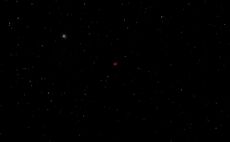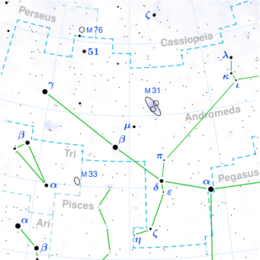Astronomy:Eta Andromedae
| Observation data Equinox J2000.0]] (ICRS) | |
|---|---|
| Constellation | Andromeda |
| Right ascension | 00h 57m 12.4000s[1] |
| Declination | +23° 25′ 03.533″[1] |
| Apparent magnitude (V) | 4.403[1] |
| Characteristics | |
| Spectral type | G8III-IV + G8III-IV[2] |
| U−B color index | +0.69[3] |
| B−V color index | +0.94[3] |
| R−I color index | +0.48[3] |
| Astrometry | |
| η And A | |
| Radial velocity (Rv) | −10.3 ± 0.9[1] km/s |
| Proper motion (μ) | RA: −43.72[1] mas/yr Dec.: −46.06[1] mas/yr |
| Parallax (π) | 13.44 ± 0.75[1] mas |
| Distance | 240 ± 10 ly (74 ± 4 pc) |
| Absolute magnitude (MV) | 0.52 ± 0.06[2] |
| η And B | |
| Absolute magnitude (MV) | 1.07 ± 0.07[2] |
| Orbit[2] | |
| Period (P) | 115.72 ± 0.01 d |
| Semi-major axis (a) | 10.37 ± 0.03 mas |
| Eccentricity (e) | 0.006 ± 0.002 |
| Inclination (i) | 30.5 ± 0.4° |
| Longitude of the node (Ω) | 69.4 ± 0.5° |
| Periastron epoch (T) | 48013 ± 1 MJD |
| Argument of periastron (ω) (secondary) | 215 ± 4° |
| Details | |
| η And A | |
| Mass | 2.6 ± 0.35[4] M☉ |
| Luminosity (bolometric) | 65 ± 3[2] L☉ |
| Surface gravity (log g) | 2.8[2] cgs |
| Temperature | 4900[2] K |
| Age | 800 Million years |
| η And B | |
| Mass | 2.3 ± 0.31[4] M☉ |
| Luminosity (bolometric) | 39 ± 3[2] L☉ |
| Surface gravity (log g) | 3.0[2] cgs |
| Temperature | 4900[2] K |
| Other designations | |
| Database references | |
| SIMBAD | data |
Eta Andromedae (Eta And, η Andromedae, η And) is a spectroscopic binary star in the constellation of Andromeda. It consists of two G-type subgiant or giant stars orbiting each other with a period of 115.7 days and has an overall apparent visual magnitude of approximately 4.403.[1][2]
History

Eta Andromedae was discovered to be a double-lined spectroscopic binary in a series of spectra taken in 1899 and 1900.[7] Its orbit was computed in 1946 from spectroscopic observations.[8] Because spectroscopy only reveals the radial velocity of a star towards or away from the viewer, such a computation does not determine all orbital elements. In observations made from 1990 to 1992, Eta Andromedae was resolved interferometrically by the Mark III Stellar Interferometer at Mount Wilson Observatory, California , United States . This allowed a more complete orbit to be computed and, in 1993, published.[2]
Naming
In Chinese, 奎宿 (Kuí Sù), meaning Legs (asterism), refers to an asterism consisting of η Andromedae, 65 Piscium, ζ Andromedae, ε Andromedae, δ Andromedae, π Andromedae, ν Andromedae, μ Andromedae, β Andromedae, σ Piscium, τ Piscium, 91 Piscium, υ Piscium, φ Piscium, χ Piscium and ψ¹ Piscium. Consequently, the Chinese name for η Andromedae itself is 奎宿一 (Kuí Sù yī, English: the First Star of Legs.)[9]
Visual companion
Eta Andromedae has a visual companion star of apparent visual magnitude 11.5, BD+22°153B, visible 129.2 arcseconds away.[6]
References
- ↑ 1.0 1.1 1.2 1.3 1.4 1.5 1.6 1.7 1.8 "* eta And". SIMBAD. Centre de données astronomiques de Strasbourg. http://simbad.u-strasbg.fr/simbad/sim-basic?Ident=%2A+eta+And.
- ↑ 2.00 2.01 2.02 2.03 2.04 2.05 2.06 2.07 2.08 2.09 2.10 2.11 The spectroscopic binary eta Andromedae: Determination of the orbit by optical interferometry, C. A. Hummel et al., Astronomical Journal 106, #6 (December 1993), pp. 2486–2492, Bibcode: 1993AJ....106.2486H, doi:10.1086/116816.
- ↑ 3.0 3.1 3.2 HR 271, database entry, The Bright Star Catalogue, 5th Revised Ed. (Preliminary Version), D. Hoffleit and W. H. Warren, Jr., CDS ID V/50. Accessed on line August 23, 2008.
- ↑ 4.0 4.1 Table 2, Resolved double-lined spectroscopic binaries: A neglected source of hypothesis-free parallaxes and stellar masses, D. Pourbaix, Astronomy and Astrophysics Supplement 145 (August 2000), pp. 215–222, Bibcode: 2000A&AS..145..215P.
- ↑ Entry 00572+2325, discoverer code MKT 2, components Aa, The Washington Double Star Catalog , United States Naval Observatory. Accessed on line August 27, 2008.
- ↑ 6.0 6.1 Entry 00572+2325, discoverer code FOX 116, components AB, The Washington Double Star Catalog , United States Naval Observatory. Accessed on line August 23, 2008.
- ↑ A list of nine stars whose velocities in the line of sight are variable, W. W. Campbell and W. H. Wright, Astrophysical Journal 12 (November 1900), pp. 254–257, Bibcode: 1900ApJ....12..254C, doi:10.1086/140765.
- ↑ The Spectroscopic Binary η Andromedae, Katherine C. Gordon, Astrophysical Journal 103 (January 1946), pp. 13–15, Bibcode: 1946ApJ...103...13G.
- ↑ (in Chinese) AEEA (Activities of Exhibition and Education in Astronomy) 天文教育資訊網 2006 年 5 月 19 日
External links
Coordinates: ![]() 00h 57m 12.4000s, +23° 25′ 03.533″
00h 57m 12.4000s, +23° 25′ 03.533″
 |


